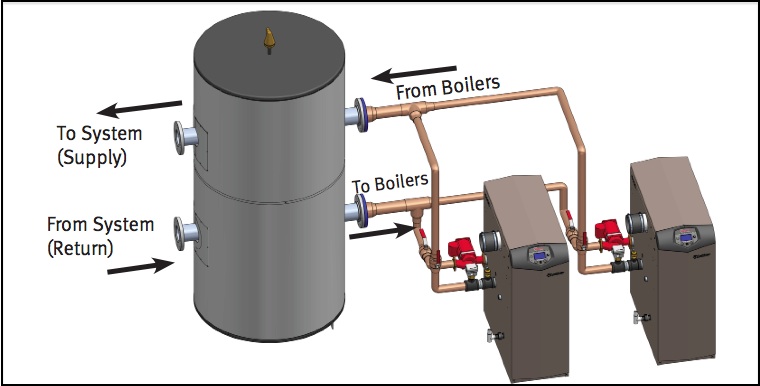Condensing Boiler Plant Piping Design & Control Part 1: Setpoint Control Sensor Location
/By Chad Edmondson
Where should the boiler set point control sensor be located in a condensing boiler system?
Given the fact that we (hopefully) know that the return water to a natural gas-fired condensing boiler should be 120°F or below in order for the boiler to condense, simple logic may lead you to believe that you should control based on the return water temperature. In other words, hold the return water temperature to 120°F or below no matter what is occurring out in the system. As such, if the load drops to 50% in a system designed for 140°F and a 20 degree delta T, the boilers will modulate down so that the return temperature stays stable while the supply temperature varies. (Assuming the system is constant speed with no changes in flow, the supply temperature would drop to 130°F at 50% load.) The delta T is halved and we maintain that all-important 120°F return water threshold necessary for our boiler(s) to condense. Seems reasonable, right?
It does, except for one minor detail: Comfort.
If we control the boiler system based solely on return temperature then the response time to changes in load will be delayed. Specifically, it will be delayed by the time it takes one gallon of water to make its way around the entire system. That’s not fast enough to satisfy the demands of most owners.
That’s why the temperature sensor for most boiler systems (even condensing boiler systems) is almost always located on the supply side of the boiler(s). Yes, we want our boilers to condense, and yes, in order to do this we must maintain the return water temperature below 120°F, but if we control solely based on return temperature then we are, in a sense, “wagging the dog”.
The next challenge then becomes setting up a control system that is not so reactionary yet still maintains sufficiently low return water temperatures – the lower the better in fact since condensing boiler efficiency increases as return water temperature decreases. A good way to do this is to evaluate the load based on flow and supply and return water temperatures; this combined data helps you to anticipate changes in demand. We then modulate and manage the boiler fire rates accordingly, maintaining the lowest possible fire, which also increases the efficiency of our condensing boilers. Remember, in a condensing boiler system it is more efficient to have multiple boilers running at low fire than a single boiler running at full fire!
How do we do all that? Sounds pretty complicated, especially when you throw variable flow pumping into the mix. How you design your boiler piping system becomes extremely critical when it comes to simultaneously maintaining temperature control and efficiency.
Over the next few blogs, we’ll take that question one scenario at a time, detailing how to properly pipe and control systems with:
- Variable primary flow
- Variable primary and variable secondary flow
- System Turndown and Multiple Boilers
- Startup Sequencing and Minimum Flow
For more information watch this video:



